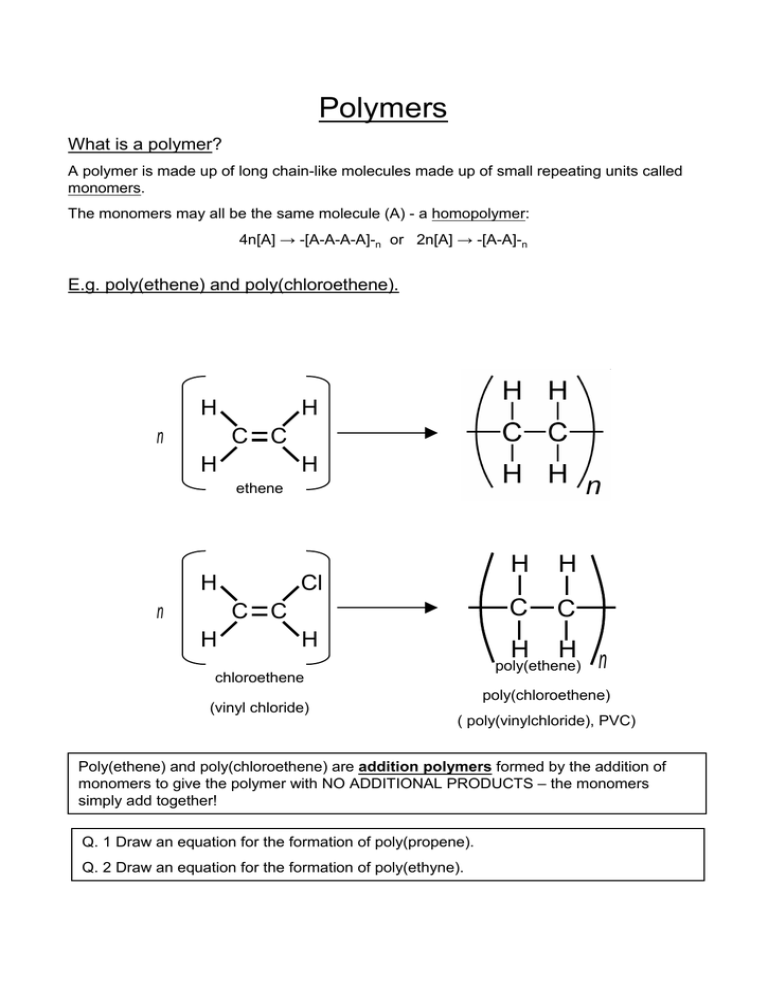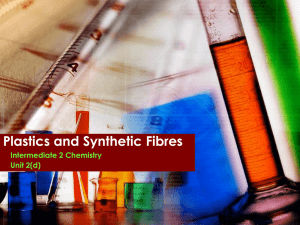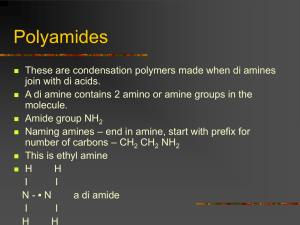Polymers
advertisement

Polymers What is a polymer? A polymer is made up of long chain-like molecules made up of small repeating units called monomers. The monomers may all be the same molecule (A) - a homopolymer: 4n[A] → -[A-A-A-A]-n or 2n[A] → -[A-A]-n E.g. poly(ethene) and poly(chloroethene). H n H C C H H ethene H n Cl C C H H H C C H H n poly(ethene) chloroethene (vinyl chloride) H poly(chloroethene) ( poly(vinylchloride), PVC) Poly(ethene) and poly(chloroethene) are addition polymers formed by the addition of monomers to give the polymer with NO ADDITIONAL PRODUCTS – the monomers simply add together! Q. 1 Draw an equation for the formation of poly(propene). Q. 2 Draw an equation for the formation of poly(ethyne). The monomers may be of several different type of molecules that repeat in the same sequence (e.g. two monomers, A and B, that alternate or two monomers that are arranged in the chain at random) – this is a heteropolymer or copolymer: 2n[A] + 2n[b] → -[A-B-A-B]-n E.g. polyamides (nylons) and polyesters. Polyamides e.g. nylons, Kevlar, proteins An amide is an organic compound containing the functional group: O O C N OR H R1 C N R3 R2 R1(CO)NR2R3 where R2 or R3 may be H. Which can result from joining a carboxylic acid, R1-COOH, to a primary amine R2-NH2 or a secondary amine, R2-(NH)-R3. E.g. nylon-6,6 n[NH2-(CH2)6-NH2] + n[HO-(CO)-(CH2)4-(CO)-OH] → -[(NH)-(CH2)6-(NH)-(CO)-(CH2)4-(CO)]-n + nH2O 1,6-diaminohexane + hexane-1,6-dioic acid → nylon-6,6 + water This is a condensation polymerisation as water is eliminated when the amide link is formed. Proteins are polyamides formed by the polymersiation of 20 different types of (alpha) amino acid: NH2-CH-COOH R Left: an amino acid – a molecule with an amine –NH2 group and a carboxylic acid –COOH group. For glycine R = H. These are a-amino acids as the R-group is on the C next to the -COOH group. Copolymerisation: formation of a copolymer. The Physical Properties of Polymers 1. Mechanical Behaviour •A. Elasticity / plasticity Elastomers: polymers with elastic properties, i.e. they return to their original shape when deformed. E.g. rubber, resilin (a protein in insect joints), elastin (a protein in ligaments). Plastics: polymers that tend to stay out of shape when deformed (plastic deformation) e.g. poly(ethene), poly(propene). Fibres: threads of polymer woven together, e.g. nylon in clothes, poly(propene) in carpets. •B. Flexibility / rigidity Flexibility: due to polymer chains sliding past each other. Rigidity: strong intermolecular forces make it hard for the fibres to slide past one another and so the polymer is ‘strong’ or hard and not easily deformed. Q. What types of intermolecular force occur between polymer chains/molecules of: i) poly(ethene)? ii) poly(chloroethene)? iii) nylons? Chain length: longer chains generally confer greater strength – larger molecules, therefore more dipole-dipole attractions; also more tangled. Side groups: e.g. –Cl in poly(chloroethene) – polar side-groups increase the strength of intermolecular forces. Branching: straight unbranched chains can pack closer together, increasing intermolecular force strength (shorter links). Stereoregularity (tacticity): •Isotactic polymers - the side-groups are arranged in a regular way, with the side-groups all pointing out from the same side of the chain, allowing the chains to pack together more closely. Often semicrsytalline and may form a helix. Some forms of poly(propene) are isotactic. •Syndiotactic polymers: the side-groups project from alternating sides of the chain, e.g. crystalline forms of polystyrene. •Atactic polymers: the side-groups project on random sides of the chain. Chain flexibility: carbon chains are very flexible, but benzene rings in the chain make it more rigid. Cross-linking: the presence of covalent bonds between adjacent chains (e.g. thermosetting polymers). Chain length: longer polymers have higher tensile strength •longer chains are more tangled together •longer chains have more points of contact where intermolecular forces can hold them together. Crystalline polymers Polymers contain crystalline regions where the chains are aligned in an orderly way (strong intermolecular forces) and amorphous regions where the chains are randomly arranged, further apart and tangled, but more free to move (more fluid). E.g. isotactic poly(propene); polymers without bulky side-groups or without branching, e.g. high-density poly(ethene). Crystalline polymers are more rigid and have higher tensile strength. 2. Electrical Behaviour Many are insulators; poly(ethyne) conducts electricity. 3. Thermal Behaviour 1. Thermoplastics -lack cross-links, so the chains are fairly free to move about when the polymer is heated – the shape changes (plastically) and the polymer can be moulded. The new shape is retained upon cooling. -e.g. poly(alkenes), polyesters (e.g. Terylene or PET used in plastic drink bottles), polyamides (e.g. nylon). 2. Thermosetting polymers (thermosets) -extensive cross-linking – retain shape upon heating. -e.g. bakelite (a copolymer of phenol and methanal), the cell wall of bacteria. Cold-drawing: Stretching a polymer causes the chains to straighten and line up, increasing strength rigidity.




